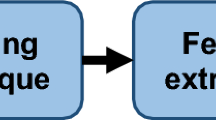Abstract
In recent studies, the chaotic behavior of a signal is confirmed using scalogram analysis of continuous-wavelet transform. Chaotic component of a speech signal can be verified through scalogram analysis, since, it investigates the periodicity content of a signal. The periodicity analysis helps in proving that a signal is not periodic, which is an essential condition on chaotic activity. In this work, a scale-index based on scalogram-analysis is calculated for a set of recordings of Arabic vowels. Also, Largest-Lyapunov Exponents (LLE) are computed for these recordings. The obtained measures are, then, compared. The comparison proves the efficacy of scale index for confirming chaotic behavior even for highly-periodic waveforms which is the case in speech vowels. Additionally, it is noted that both LLE and scale-index exhibit classification ability for Arabic vowels.







Similar content being viewed by others
References
Addison, P. S. (2005). Wavelet transforms and the ECG: a review. Physiological Measurement, 26, R155–R199.
Adeli, H., Ghosh-Dastidar, S., & Dadmehr, N. (2007). A wavelet-chaos methodology for analysis of EEGs and EEG subbands to detect seizure and epilepsy. IEEE Transactions on Biomedical Engineering, 54(2), 205–211.
Benítez, R., Bolós, V. J., & Ramírez, M. E. (2010). A wavelet-based tool for studying non-periodicity. Computers and Mathematics with Applications, 60(3), 634–641.
Cantón, E. C., & Murguía, J. S. (2006). Wavelet analysis of chaotic time series. Revista Mexicana de Física, 52(2), 155–162.
Chavan, M. S., Mastorakis, N., Chavan, M. N., & Gaikwad, M. S. (2011). Implementation of SYMLET wavelets to removal of Gaussian additive noise from speech signal. In Proceeding of 10th WSEAS international conference on signal processing, robotics and automation, Wisconsin, USA (pp. 37–41).
Chen, G., Hsu, S., Huang, Y., & Roque-Sol, M. (2011). The spectrum of chaotic time series (II): wavelet analysis. International Journal of Bifurcation and Chaos, 21(5), 457–1467.
Esposito, A., & Marinaro, M. (2005). Some notes on nonlinearities of speech. In Lecture notes in computer science: Vol. 3445. Nonlinear speech modeling and applications (pp. 1–14). Berlin: Springer.
Faúndez-Zanuy, M., McLaughlin, S., Esposito, A., Hussain, A., Schoentgen, J., Kubin, G., Kleijn, W. B., & Maragos, P. (2002). Non-linear speech processing: overview and applications. Control and Intelligent Systems, 30(1), 1–10.
Hesham, M. (2006). A predefined wavelet packet for speech quality assessment. Journal of Engineering and Applied Sciences, 53(5), 637–652.
Hou, Y. (2010). A compactly supported, symmetrical and quasi-orthogonal wavelet. International Journal of Wavelets, Multiresolution and Information Processing, 8(6), 931–940.
Jiang, J. J., Zhang, Y., & McGilligan, C. (2006). Chaos in voice, from modeling to measurement. Journal of Voice, 20(1), 2–17.
Kia, B., Ditto, W. L., & Spano, M. L. (2011). Chaos for speech coding and production. In C. M. Travieso-González & J. Hernández (Eds.), NOLISP (pp. 270–278). Berlin: Springer.
Kokkinos, I., & Maragos, P. (2006). Nonlinear speech analysis using models for chaotic systems. IEEE Transactions on Speech and Audio Processing, 13(6), 1098–1109.
Lei, M., Wang, Z., & Feng, Z. (2002). The application of symplectic geometry on nonlinear dynamics analysis of the experimental data. In DSP 2002 (Vol. 2, pp. 1137–1140).
Lin, J., Huang, Z., Wang, Y., & Zhenken, S. (2000). Selection of proper embedding dimension in phase space reconstruction of speech signals. J. of Electron., 17(2), 161–169.
Liu, H. F., & Dai, Z. H. (2005). Noise robust estimates of the largest Lyapunov exponent. Physics Letters A, 341(1–4), 119–127.
Liu, X., Povinelli, R., & Johnson, M. (2003). Vowel classification by global dynamic modeling. In ISCA tutorial and research workshop on non-linear speech processing (NOLISP), Le Croisic, France.
Long, Y., Gang, L., & Jun, G. (2004). Selection of the best wavelet base for speech signal. In Proceedings of 2004 international symposium onIntelligent multimedia, video and speech processing, 20–22 Oct. (pp. 218–221).
Mallat, S. (1999). A wavelet tour of signal processing. London: Academic Press.
Maragos, P., Dimakis, A. G., & Kokkinos, I. (2002). Some advances in nonlinear speech modeling using modulations, fractals, and chaos. In DSP, 2002 (Vol. 1, pp. 325–332).
Mohammadi, S. (2009). LYAPROSEN: MATLAB function to calculate Lyapunov exponent. Statistical software components T741502. http://ideas.repec.org/e/pmo194.html.
Ouahabi, A., & Femmam, S. (2011). Wavelet-based multifractal analysis of 1-D and 2-D signals: new results. Analog Integrated Circuits and Signal Processing, 69(1), 3–15.
Palus, M., & Dvorak, I. (1992). Singular-value decomposition in attractor reconstruction: pitfalls and precautions. Physica D, 55(1–2), 221–234.
Pitsikalis, V., & Maragos, P. (2002). Speech analysis and feature extraction using chaotic models. In ICASSP 2002 (pp. 533–536).
Pitsikalis, V., & Maragos, P. (2006). Filtered dynamics and fractal dimensions for noisy speech recognition. IEEE Signal Processing Letters, 13(11), 711–714.
Rosenstein, M. T., Collins, J. J., & De Luca, C. J. (1993). A practical method for calculating largest Lyapunov exponents from small data sets. Physica D, 65(1–2), 117–134.
Vaziri, G., Almasganj, F., & Behroozmand, R. (2010). Pathological assessment of patients’speech signals using nonlinear dynamical analysis. Computers in Biology and Medicine, 40, 54–63.
Watada, J., & Matsumoto, Y. (2007). Wavelet approach to chaotic forecasting of stock movement. Asia Pacific Journal of Finance and Banking Research, 1(1), 34–44.
Wickerhauser, M. V. (1994). Adapted wavelet analysis from theory to software. New York: IEEE Press.
Author information
Authors and Affiliations
Corresponding author
Rights and permissions
About this article
Cite this article
Hesham, M. Wavelet-scalogram based study of non-periodicity in speech signals as a complementary measure of chaotic content. Int J Speech Technol 16, 353–361 (2013). https://doi.org/10.1007/s10772-013-9187-3
Received:
Accepted:
Published:
Issue Date:
DOI: https://doi.org/10.1007/s10772-013-9187-3




